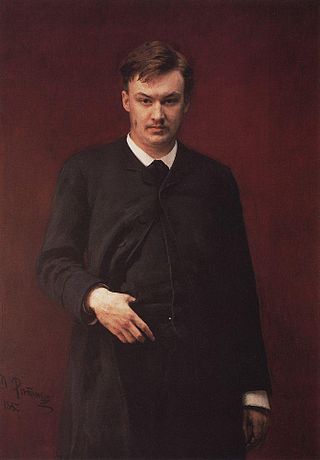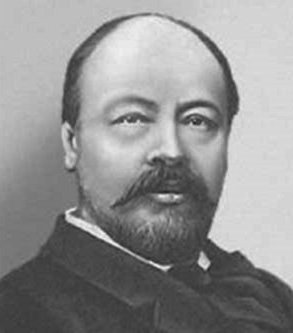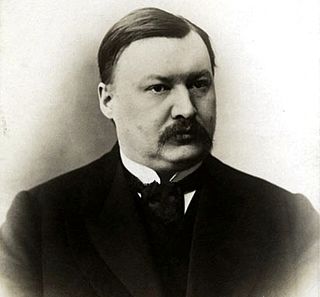The Symphony No. 6 in C minor, Op. 58, was composed by Alexander Glazunov in 1896, and was published two years later. It is dedicated to Felix Blumenfeld.
Contents
It is in four movements:
The Symphony No. 6 in C minor, Op. 58, was composed by Alexander Glazunov in 1896, and was published two years later. It is dedicated to Felix Blumenfeld.
It is in four movements:
The symphony is scored for the following orchestra: 3 flutes (3rd doubling piccolo), 2 oboes, 3 clarinets, 2 bassoons, 4 horns, 3 trumpets, 3 trombones, tuba, timpani, triangle, cymbals, bass drum, and strings. [1]

Alexander Konstantinovich Glazunov was a Russian composer, music teacher, and conductor of the late Russian Romantic period. He was director of the Saint Petersburg Conservatory between 1905 and 1928 and was instrumental in the reorganization of the institute into the Petrograd Conservatory, then the Leningrad Conservatory, following the Bolshevik Revolution. He continued as head of the Conservatory until 1930, though he had left the Soviet Union in 1928 and did not return. The best-known student under his tenure during the early Soviet years was Dmitri Shostakovich.

Anatoly Konstantinovich Lyadov was a Russian composer, teacher, and conductor.

Giuseppe Martucci was an Italian composer, conductor, pianist and teacher. Sometimes called "the Italian Brahms", Martucci was notable among Italian composers of the era in that he dedicated his entire career to absolute music, and wrote no operas. As a composer and teacher he was influential in reviving Italian interest in non-operatic music. Nevertheless, as a conductor, he did help to introduce Wagner's operas to Italy and also gave important early concerts of English music there.

The Violin Concerto in A minor, Op. 82, by Alexander Glazunov is one of his most popular compositions. Written in 1904, the concerto was dedicated to violinist Leopold Auer, who gave the first performance at a Russian Musical Society concert in St. Petersburg on 15 February 1905. The British premiere of the concerto followed just over a year later, under the direction of Sir Henry Wood and with Mischa Elman as soloist.
The Symphony No. 4 in E-flat major, Op. 48, was written by Alexander Glazunov in 1893. The symphony was a departure from Glazunov's three earlier symphonies, which were based on nationalistic Russian tunes and, according to the composer, allowed him to give "personal, free, and subjective impressions of myself."
The Symphony No. 5 in B-flat major, Op. 55, was written by Alexander Glazunov from April to October 1895. Although in this symphony Glazunov returned to his conventional four-movement layout he frequently utilizes thematic transformation.

The Andante and Finale is a composition for piano and orchestra that was reworked by Sergei Taneyev from sketches by Pyotr Ilyich Tchaikovsky for the abandoned latter movements of his single-movement Piano Concerto No. 3 in E-flat, Op. 75.
Cello Concerto in E minor, Op. 58 is a concerto written by Sergey Prokofiev between 1933 and 1938. Its duration is approximately 35 minutes. It consists of three movements:
Alexander Glazunov composed his Symphony No. 3 in D major, Op. 33, in 1890, and it was published by 1892 by the Leipzig firm owned by Mitrofan Belyayev. The symphony is dedicated to Pyotr Ilyich Tchaikovsky and was first performed in St. Petersburg in December 1890 under the baton of Anatoly Lyadov. The symphony is considered a transitional work, with Glazunov largely eschewing the influences of Balakirev, Borodin, and Rimsky-Korsakov inherent in his earlier symphonies for the newer influences of Tchaikovsky and Wagner. Because of this change, the Third has been called the "anti-kuchkist" symphony in Glazunov's output. He would tone down these new influences in his subsequent symphonies as he strove for an eclectic mature style. The Third also shows a greater depth of expression, most evident in the chromatic turns of its third movement, reminiscent of Wagner's opera Tristan und Isolde.
Anna Karenina is a ballet choreographed by Boris Eifman, based on the 1877 novel Anna Karenina by Leo Tolstoy. The première took place in Saint Petersburg on Saturday, 2 April 2005. The music is by Pyotr Ilyich Tchaikovsky and includes excerpts from:
The Symphony No. 7 in F major, Pastoral, Op. 77, was completed by Alexander Glazunov on July 4, 1902. It is dedicated to Mitrofan Belyayev.
The Symphony No. 1 in C minor, Op. 3, by Nikolai Myaskovsky was written in 1908.
Album leaf is the title of numerous minor compositions by a wide variety of classical composers. It also appears in the French version, Feuille d'album or Feuillet d'album; the German version Albumblatt ; the Russian version Листок из альбома ; the Spanish and Latin-American versions Hoja de álbum; and other languages.
The Symphony No. 3 in B minor "Ilia Mourometz", Op. 42, is a large symphonic work by Russian composer Reinhold Glière. A program symphony, it depicts the life of Kievan Rus' folk hero Ilya Muromets. It was written from 1908 to 1911 and dedicated to Alexander Glazunov. The premier took place in Moscow on 23 March 1912 under Emil Cooper, and in 1914 the piece earned Glière his third Glinka Award.
The Symphony No. 8 in E-flat major, Op. 83, was composed by Alexander Glazunov in 1905, and was published two years later. This four-movement symphony was premiered on December 22, 1906 in Saint Petersburg, the composer conducting. It was an important influence on Igor Stravinsky's Symphony in E-flat.
The Symphony No. 2 in F-sharp minor, Op. 16, was composed by Alexander Glazunov in 1884–1886, premiered in 1886 in St Petersburg, and published in 1889. It is dedicated to the memory of Franz Liszt.

Commemorative Cantata for the Centenary of the Birth of Pushkin, Op. 65, is a cantata by Alexander Glazunov, composed in 1899 in memory of author Alexander Pushkin. It is also known as Memorial Cantata and Cantata in Memory of Pushkin's 100th Birthday. The work in five movements on lyrics by Konstantin Romanov is scored for solo voices, choir and piano.